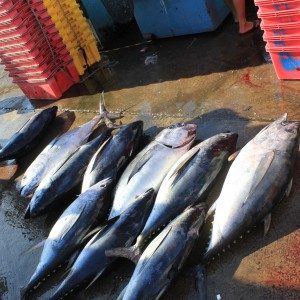
Mattanza: Sicily's Traditional Tuna Fishing
The Tuna in the Mediterranean Sea
The Northern Bluefin tuna meat ranges from low fat and a vermilion color to a deep red, with strong flavor and fatty flesh in the adult fish. The lifespan of the Northern bluefin tuna is estimated between 30 to 40 years. Part of the Northern bluefin tuna caught in the Californian, Mexican and Eastern Atlantic coasts is sold fresh in the USA markets, a portion of them are exported to the Asian markets, and some go to American fisheries to be canned in oil or water. The Northern bluefin tuna that migrate toward the European coasts pass by the North Sea, the British Isles, the Canary Islands, then they go to the Mediterranean Sea and move to the Black Sea spawning in the warm waters following a predetermined itinerary embedded in their genes.
In the Mediterranean Sea, tuna fishing is done at the end of spring and it lasts about a month. This is the time when the tuna fish run by the side of the Sicilian coastline towards the Adriatic Sea and the Black Sea to lay the eggs. In the nineteen century, in Italy there were over 100 “tonnare” –tuna fishing complex traps with nets, set along the Italian coasts-, at present the number of tonnare allowed to catch tuna are reduced to three, implementing regulations to limiting the tuna fishing to save this species from becoming endangered. In Sicily, one “tonnara” is located at Favignana, a small island less then 5 miles from Trapani, another is placed in the shore of Bonagia a small fishing village at the foot of mount Erice near Trapani.
The third tonnara is located in Carloforte, on the island of San Pietro near the south-west coast of Sardinia. In Liguria at Camogli, and in the Adriatic and Tyrrhenian coasts, recreational and commercial tuna fishing is still active in a very controlled and limited scale. Fishermen bring the tuna fish to the market to be sold for fresh consumption in restaurants and households.
The Mattanza
The technique of fishing in Sicily and Sardinia is called “Mattanza”, meaning killing or slaughter. Mattanza is the final part of tuna fishing by a system of colossal nets extending almost a mile at a 45-degree angle from the shore or a boa. Along with this net, there are a series of chambers made also of nets and connected to each other with net doors. When the tuna going forward finally enters into the last chamber called the “camera della morte”– the death chamber- to be slaughtered, it is lifted by means of big hooks, placed in boats and taken to the cannery. When a large number of tuna is amassed in the last chamber, the fishermen partially hoist the net so the giant tuna trying to escape hit each other with their heavy body, the average weight is over 1000 pound, causing injuries and deep cuts with their sharp tails causing them to lose a lot of blood and strength so they can be easily hoisted to the boats.
A multitude of tourist crowd the boats set aside for them to assist this spectacle. The sea is tinted red with the blood of these beautiful and strong exemplars of the marine fauna; it is an unforgettable display of brutality and of the need of man to provide for his survival. Returning to the shore, most of the visitors, including me, had a sad look that promptly disappeared when our host invited all of us for a snack offering bottarga, salted tuna roe, young cheeses, assorted cold cut, caponatina, local wine, and some delicious cannoli, slices of Cassata Siciliana, and an old Marsala wine.
